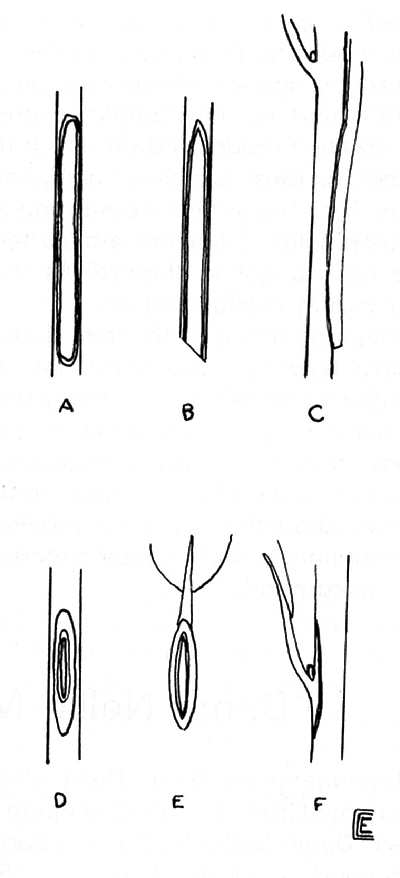The Veneer Side Graft
by John and Eveleth Cowles, Wellesley, Mass.
Reprinted from the Rosebay, Massachusetts Chapter

|
|
DIAGRAMS
A. Front view of stock prepared for grafting
|
This method can be used for grafting both the normal scion and also for buds. The ideal stock is plump and green to the ground, usually a well rooted cutting of about a pencil's thickness. This is bent slightly, and a shallow downward and inward cut of 1" to 2" long is made, using a very sharp knife or single-edge razor blade. The most shapely plants result from grafts close to the base of the stock. The best scion is a stem of the same diameter as the stock. Prepare by making a slanting cut of 1 " to 2" long.
The crucial step is to match accurately the cambial layer of the scion to the cambial layer of the stock. The cambium in green-barked material is the thin boundary layer, two cells thick, that separates the cream-colored woody inner tissue from the outer pulpy bark tissue. When bark is pulled off it parts along the cambial layer. In green wood the cambium often appears colorless and translucent. When the scion is smaller than the stock, match up the cambium on one side of the scion exactly to the cambium on one side of the stock.
A bud graft uses the same technique with slight modification. For the bud scion, select one of the lower leaves from the whorl of the current year's growth. Make a shallow cut along the length of the stem, from ½" above the axillary bud next to the stem, coming out ½" below it.
Clear excess leaves from the section of stock where you wish to place the graft. Bend the stock slightly and make a shallow downward cut to remove a piece a little lager than the bud scion. Match the cambium layers precisely, sliding the scion upwards to fit the top of the hollow in the stock.
A number of materials can be used to secure scion to stock during the ten weeks required to knit. Thin cotton twine is the most common. Electrical scotch tape, soft wire, elastic bands, and snap-type clothes pins also can be used. Start at the base of the scion. Pass tying material around several times, overlapping to secure it. Make certain that the scion does not shift, and in the case of a bud graft be sure that the string does not damage the axillary bud. Wrap the string, etc. in an upward spiral around the graft to assure firm contact for the full length of the two surfaces. Tie or fasten securely at the top.
Select a polyethylene bag, such as a bread bag, into which the plant will fit comfortably, and sprinkle a small amount of water into it. Sprinkle the scion leaf or leaves lightly and place the plant in the bag. Don't wet the wound area. The inside of the bag should show moisture at all times. Water of condensation at the top of the bag should be in contact with the leaf or leaves of the scion.
Fasten the top of the bag securely with a tie. Place in bright light but never in direct sun. Grafts knit best at 60° to 75° F.
A special method of bagging is used when making summer grafts out of doors. In this case the section of the branch with the graft is tightly enclosed in a plastic bag, which in turn is covered with a brown paper bag for shading.
The first sign of successful knitting will be the appearance of cream-colored callous tissue along the edge of the cut. Do not unite until the string appears to be strangling the scion, at from 12 to 16 weeks. Before this the union is very weak and snaps off easily. At this time the scion or leaf bud shows active growth. Carefully prune off the top of the stock or rub out the buds on the stock, favoring the scion.
Grafting is most commonly practiced to increase stock that is difficult to root or to propagate during warm weather. There are several other special applications.
It can be a great advantage in a breeding program to hasten the flowering of seedlings. Rapid maturation is accomplished by grafting a seedling high up onto an older plant.
There is potential for improved resistance to cold or heat. Winter-kill in marginally hardy rhododendrons often appears to result from death of the roots. Experimental grafting of these on to hardy stock may prove them adaptable to colder areas.
Some species and hybrids (
aureum
, Carmen) are intolerant of our hot summers. They rapidly fall prey to soil pathogens, from water-molds to Phytophthora. Grafting this type of plant on to a tough root stock should increase its viability.